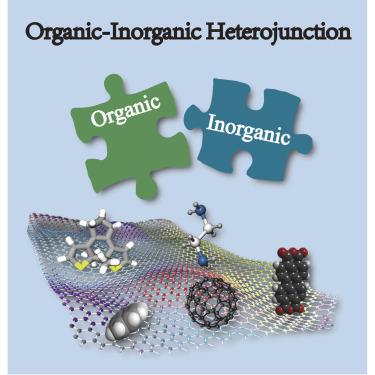Cell Reports Physical Science ( IF 8.9 ) Pub Date : 2020-08-26 , DOI: 10.1016/j.xcrp.2020.100166 Ke Pei , Tianyou Zhai

|
The unique properties of two-dimensional (2D) materials have boosted intensive interests in combining distinct 2D materials into van der Waals heterojunctions for novel device structures. The organic-inorganic heterojunctions, integrating atomically thin inorganic materials with an unlimited variety of organic molecules, provide an ideal platform for broader, superior, and on-demand functional applications by incorporating customized organic molecules that particularly exhibit decent optoelectronic properties, promising scalability and remarkable flexibility. In this Review, emerging 2D organic-inorganic heterojunctions from the perspectives of materials, manufacturing, structures, and interfaces, as well as recent progress in functional applications, are provided. Two prototypical construction approaches are summarized—epitaxy growth and molecular doping—followed by four directions of device applications, including electronic device, optoelectronic device, energy harvesting device, and memory and neuromorphic device. Finally, the frontier challenges and future outlook associated with the organic-inorganic heterojunctions are highlighted, which is critical for the further development of this cross-fertilized research field.
中文翻译:

新兴的2D有机-无机异质结
二维(2D)材料的独特性能引起了人们的浓厚兴趣,他们将独特的2D材料组合到范德华异质结中以形成新颖的器件结构。有机-无机异质结将原子稀薄的无机材料与无限多种有机分子结合在一起,通过结合定制的有机分子特别是提供了体面的光电性能,可扩展性和出色的定制有机分子,为广泛,优越和按需功能应用提供了理想的平台。灵活性。在这篇综述中,从材料,制造,结构和界面以及功能应用的最新进展的角度,提供了新兴的二维有机-无机异质结。总结了两种典型的构造方法-外延生长和分子掺杂-其次是设备应用的四个方向,包括电子设备,光电设备,能量收集设备以及内存和神经形态设备。最后,强调了与有机-无机异质结相关的前沿挑战和未来前景,这对于该交叉受精研究领域的进一步发展至关重要。



























 京公网安备 11010802027423号
京公网安备 11010802027423号